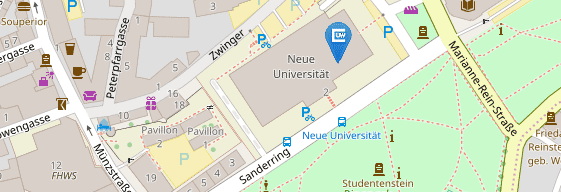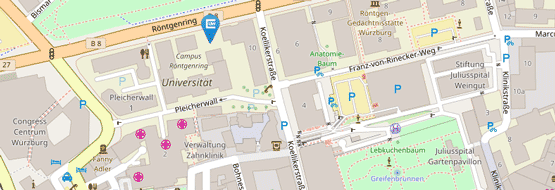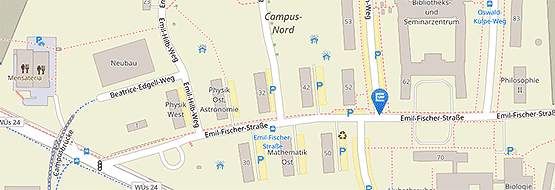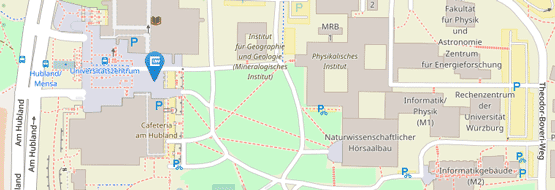Intrigue among Gods - as a Mirror of Mankind
11/04/2025Homer's "Iliad" provides a blueprint for how base instincts unleash violence that is still valid today. A key scene from the epic is depicted in a high-ranking painting. It has now been acquired for the Martin von Wagner Museum.
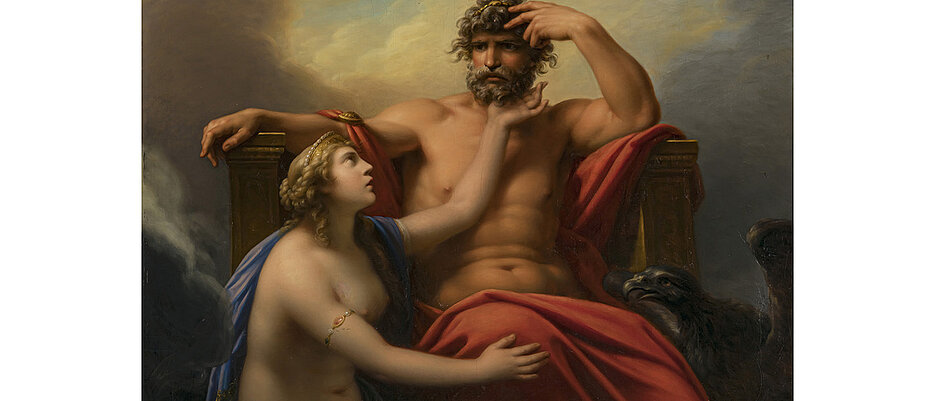
Martin von Wagner (1777-1858) held the memory of his Viennese academy teacher Heinrich Friedrich Füger in high honour well into old age. However, the University of Würzburg's art museum, named after Wagner, did not yet own a painting by him.
With the acquisition of Füger's monumental painting "Thetis before Zeus", this gap has now been closed, and in the most fitting way possible: From now on, it will hang in the Picture Gallery opposite Martin von Wagner's "Council of the Greeks before Troy".
Inspired by Homer's Work
The monumental scale of the figures - "Thetis before Zeus" is over two metres high - links the paintings by teacher and pupil, as does the Homeric subject matter: Wagner draws from the tenth canto of the Iliad, Füger from the first.
In the middle of the Trojan War, the sea goddess Thetis wants to avenge her son Achilles; he had been dishonoured by Agamemnon, the leader of the Greek army. With tender words and gestures, she finally persuades the initially hesitant Zeus to turn the tide of war in favour of the Trojans. The bloody events drag on, with great losses on the part of the Greeks.
In his work, first exhibited in 1813, Füger focused on the emotional aspects of the Olympic encounter, adding strikingly erotic accents. It is possible that he wanted to compete with the painting of the same subject presented by Jean-Auguste-Dominique Ingres in Paris in 1811. However, the relationship between the two canvases still harbours material for future research.
"A Truly Museum-quality Painting"
"The painting is well known to Füger researchers, and the work occupies an outstanding position within his oeuvre," says Damian Dombrowski, Director of the Modern Department at the Martin von Wagner Museum, emphasising the significance of the purchase. The professor of art history calls "Thetis before Zeus" a "truly museum-quality painting - in terms of its dimensions alone, but even more so due to its quality in terms of composition, colour and texture."
At the same time, it reflects the Homer enthusiasm of the decades around 1800, for which Martin von Wagner's almost one thousand drawings for the "Iliad" are the most extensive artistic evidence. The University Museum, which increasingly sees itself as a research centre for the art of the 'Sattelzeit', dedicated a comprehensive exhibition to them in 2023.
Rare Opportunity Utilised
The painting was purchased from the Munich auction house Neumeister. Half of the costs were covered by the Ernst von Siemens Art Foundation, with the remainder being shared by the Association of Friends of the Würzburg Residence and Julius Maximilian University.
In order to receive the grant from the Ernst von Siemens Art Foundation, an expert opinion had to be submitted within a very short space of time. The Göttingen professor Michael Thimann, who specialises in early 19th century painting, did not take long to do so - his enthusiasm is evident in the expert opinion.
"A New Highlight of the Collection"
In it, Thimann emphasises on the one hand that such large gallery paintings are extremely rare in the art trade. On the other hand, he emphasises the relevance of the painting for the Martin von Wagner Museum - also because Füger was not only Wagner's teacher at the Vienna Academy of Fine Arts, but also Friedrich Overbeck, who became a key figure for the Nazarene group of artists.
The University Museum owns an important painting by Overbeck from the collection of Ludwig Brüls, a German-Roman friend of Martin von Wagner. "Füger's painting would therefore complement the Martin von Wagner Museum's holdings perfectly and would definitely be a new highlight of the collection," summarises Thimann.
This judgement can now be verified on site. The painting will be officially unveiled at the beginning of December during the "Wagner Days", with which the previous Winckelmann celebrations will be equalised for the first time this year.
Thanks to this new acquisition, the hall of the Picture Gallery dedicated to 'Enlightenment and Classicism' is now even more clearly centred on Homer. Martin von Wagner's favourite poet is represented there not least in a remarkable terracotta bust, on loan from the Museum für Franken.
Lessons from Mythology
The other Homeric painting is not only a historical monument to Goethe's time. "By recalling the events of the Trojan War, it also raises questions that are once again topical in times of global political unrest," Dombrowski points out.
"On the surface, Thetis acts out of maternal compassion for her son. But in reality, she risks the downfall of the entire Greek army because of a single offence." The museum director therefore also sees the painting as a cautionary tale of how the powerful of all times pursue their own selfish motives - and in doing so plunge their own peoples into ruin.
Opening Hours and "Wagner Days"
The Picture Gallery of the Martin von Wagner Museum at the University of Würzburg is open Monday to Saturday from 1.30 pm to 5 pm, and on Sundays from 10 am to 1.30 pm, alternating with the Collection of Classical Antiquities.
The Picture Gallery is currently closed for repairs to the heating system and will reopen in mid-November.
The "Wagner Days" will take place again in December. The programme - consisting of the Wellhöfer Lecture, Winckelmann Lecture and Wagner Report with wine reception - can be downloaded here.


